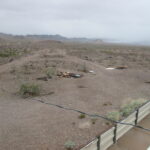The last day of March some scavenger children discovered a body in the El Chile dump, in a complete state of decomposition. What was left of it was removed to the city’s Institute of Forensic Anatomy, where all the usual procedures were performed. It appeared that the victim was somewhere between fifteen and twenty years old. According to the medical examiners, she had died more than twelve months ago, and the cause of death was unable to be determined. This information nevertheless caught the attention of the González Reséndiz family, of Guanajuato, whose daughter had disappeared around that time, and the Guanajuato police requested the forensic report for the El Chile victim from the Santa Teresa police, putting special emphasis on the dental evidence. Once the evidence was received, it was confirmed that the victim was Irene González Reséndiz, sixteen, who had run away from home in January 1996 after a quarrel with her family. Her father was a well-known local PRI politician and her mother had appeared on a popular TV show, live before the cameras, asking her daughter to come home. Even a passport-style picture of Irene was printed on the labels of milk bottles, with her physical description and a telephone number. No Santa Teresa policeman ever saw the picture. No Santa Teresa policeman drank milk. None but Lalo Cura.
Roberto Bolaño, 2666
100th post on this silly little blog! Somehow Bolaño feels fitting, and particularly an excerpt from 2666, which I first encountered when Grant lent it to me at the bike shop where we both worked years ago. I miss working with creative, literate people.
I remember conversations about terrible writers and conversations about wonderful writers. I remember conversations about Julio Cortázar, about Nicanor Parra, about Adolfo Bioy Casares, Juan Carlos Onetti, and Juan Rulfo. I have a very clear memory of a conversation about Malcolm Lowry and Louis-Ferdinand Céline, from which the former came out unexpectedly better than the latter, because — this was the conclusion Bolaño reached, or we reached — he wanted to escape from hell, while the other felt comfortable there. I remember long conversations about English- and French-language poets, about Eliot and Baudelaire, and about North American fiction writers, about Poe, Hemingway, Philip K. Dick, Kurt Vonnegut, and John Irving, who he didn’t like but I did. I remember endless conversations about Borges that almost always ended with Bolaño’s laughter as we recited those memorable lines from Carlos Argentino Daneri’s topographical epic:
Know ye. To the right of the routinary post
(Coming, of course, from the North-northwest)
One wearies out a skeleton — Color? White-celeste—
Which gives the sheep run an ossuary cast.
So remembers Javier Cercas in The Paris Review.
I also remember him talking to me about the structure of 2666 and a novel about bullfighters that he never finished (as far as I know), and which, he said, would be called Corrida. I remember him reading me a long poem about his father, which I don’t think I’ve read in any of his books. I don’t remember, however, him talking to me about his illness (in fact, I don’t remember him talking about that with anybody, except for my sister Blanca, who suffered from a similar illness), but I remember very well that on the early morning of November 22, 2000, after we’d been talking for a long time, the phone rang and it was him again. He’d just seen on television that the Basque separatist group ETA had killed Ernest Lluch, and, shocked, called me to talk about that news, which prolonged our conversation until two or three in the morning.




Leave a Reply